Thermal-Flow Characteristics of Ferrofluids in a Rotating Eccentric Cylinder under External Magnetic Force
Abstract
:1. Introduction
2. Methodology
3. Results and Discussion
3.1. Magnetophoretic Force
3.2. Velocity Distribution
3.3. Nusselt Number
4. Conclusions
- When a magnetic field is applied to a ferrofluid through the permanent magnet, magnetization distribution appears due to magnetic flux density distribution. It was confirmed that the MAP force was concentrated in the portion where the magnetic flux density gradient was large. It has also been confirmed that various velocity changes and vortex fields are generated by the MAP force.
- Since the center of the inner cylinder moves away from the center of the outer cylinder, it has a higher Nusselt number because it forms a sufficient flow. However, it has been confirmed that the effect of heat transfer is reduced by direct contact when it is too close to the outer wall. Therefore, the highest Nusselt number was confirmed in Case 4 (e = 0.3), which is considered to be the most appropriate location.
- The eccentricity of the inner cylinder was found to influence the vortex field under the magnetic field. It is considered that a highly efficient heat dissipation system can be constructed by using the characteristic that a change in efficiency is caused by a small eccentricity change. However, a comparative study of the results obtained from the experiment should be performed to confirm the accuracy of numerical studies.
- The characteristics of the heat transfer according to the eccentricity of the ferrofluids can be applied to various rotating devices such as electric motors and generators.
Author Contributions
Funding
Acknowledgments
Conflicts of Interest
References
- Kim, S.C. Thermal Design and Analysis Evaluation of ISG Motor for Hybrid Electric Vehicles considering High-speed Driving Condition. Trans. Korean Soc. Automot. Eng. 2014, 22, 59–64. [Google Scholar] [CrossRef]
- Matin, M.H.; Pop, I. Natural convection flow and heat transfer in an eccentric annulus filled by Copper nanofluid. Int. J. Heat Mass Transf. 2013, 61, 353–364. [Google Scholar] [CrossRef]
- Jeng, T.M. Combined convection and radiation heat transfer of the radially finned heat sink with a built-in motor fan and multiple vertical passages. Int. J. Heat Mass Transf. 2015, 80, 411–423. [Google Scholar] [CrossRef]
- Li, T.; Fang, Y.; Ma, J.; Liang, S.; Shi, C. Optimization of motor heat dissipation systems based on three dimensional flow field analysis. In Proceedings of the 2015 18th International Conference on Electrical Machines and Systems (ICEMS), Pattaya, Thailand, 25–28 October 2015. [Google Scholar]
- Oh, D.G. Heat Dissipation-Improved Motor. KR Patent 0024487A, 10 April 2014. [Google Scholar]
- Lee, M.Y.; Kim, H.J.; Lee, W.Y. Numerical analysis on temperature characteristics of the voice-coil for woofer speaker using ferrofluid. J. Korean Magn. Soc. 2013, 23, 166–172. [Google Scholar] [CrossRef]
- Petit, M.; Avenas, Y.; Kedous-Lebouc, A.; Cherief, W.; Rulliere, E. Experimental study of a static system based on a magneto-thermal coupling in ferrofluids. Int. J. Refrig. 2014, 37, 201–208. [Google Scholar] [CrossRef]
- Kim, H.J.; Seo, J.H.; Kim, D.W.; Lee, M.Y.; Seo, Y.S. Thermal-flow characteristics of magnetic fluid for concentric annuli under fixing magnetic field using visualization technique. J. Korean Magn. Soc. 2013, 23, 26–30. [Google Scholar] [CrossRef]
- Hu, Y.; Li, D.; Shu, S.; Niu, X. Natural convection in a nanofluid-filled eccentric annulus with constant heat flux wall: A lattice Boltzmann study with immersed boundary method. Int. Commun. Heat Mass Transf. 2017, 86, 262–273. [Google Scholar] [CrossRef]
- Abu-Nada, E.; Masoud, Z.; Hijazi, A. Natural convection heat transfer enhancement in horizontal concentric annuli using nanofluids. Int. Commun. Heat Mass Transf. 2008, 35, 657–665. [Google Scholar] [CrossRef]
- Sheikholeslami, M.; Gorji-Bandpy, M.; Ganji, D.D. MHD free convection in an eccentric semi-annulus filled with nanofluid. J. Taiwan Inst. Chem. Eng. 2014, 45, 1204–1216. [Google Scholar] [CrossRef]
- Hamid, T.; Ghanbar, A.S.; Masoud, A.; Mohammad, M.F. Mixed convection in a rotating eccentric annulus containing nanofluid using bi-orthogonal grid types: A finite volume simulation. J. Mol. Liq. 2017, 227, 114–126. [Google Scholar]
- COMSOL Multiphysics ver. 3.5a Manual. Available online: https://cn.comsol.com/products/news/3.5 (accessed on 10 September 2018).
- Kuehn, T.H.; Goldstein, R. An experimental study of natural convection heat transfer in concentric and eccentric horizontal cylindrical annuli. J. Heat Transf. 1978, 100, 635–640. [Google Scholar] [CrossRef]
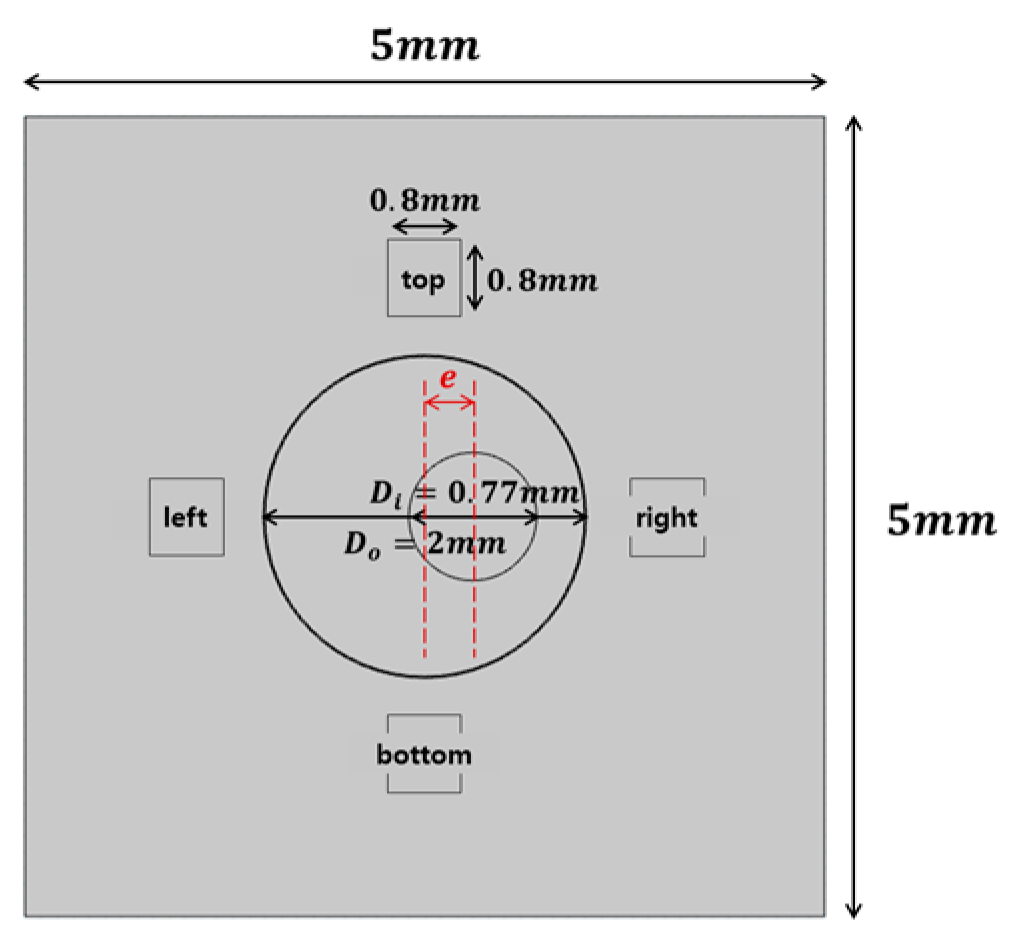
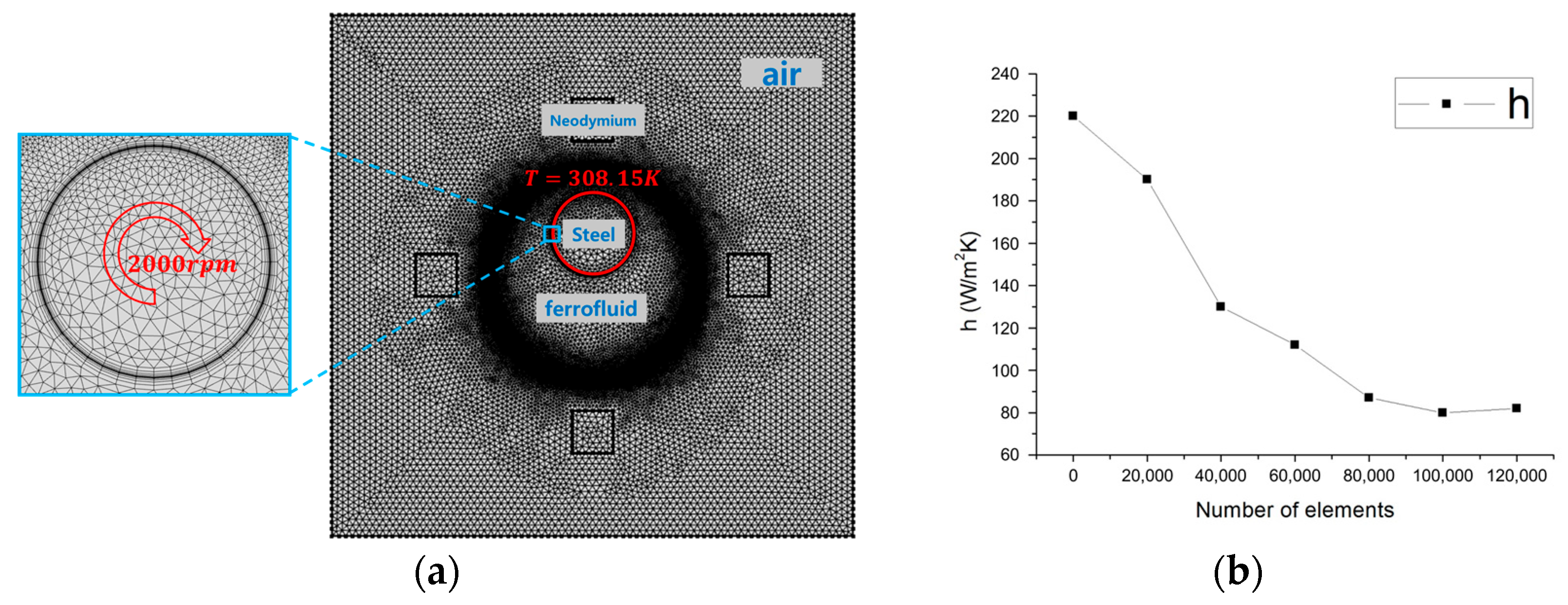
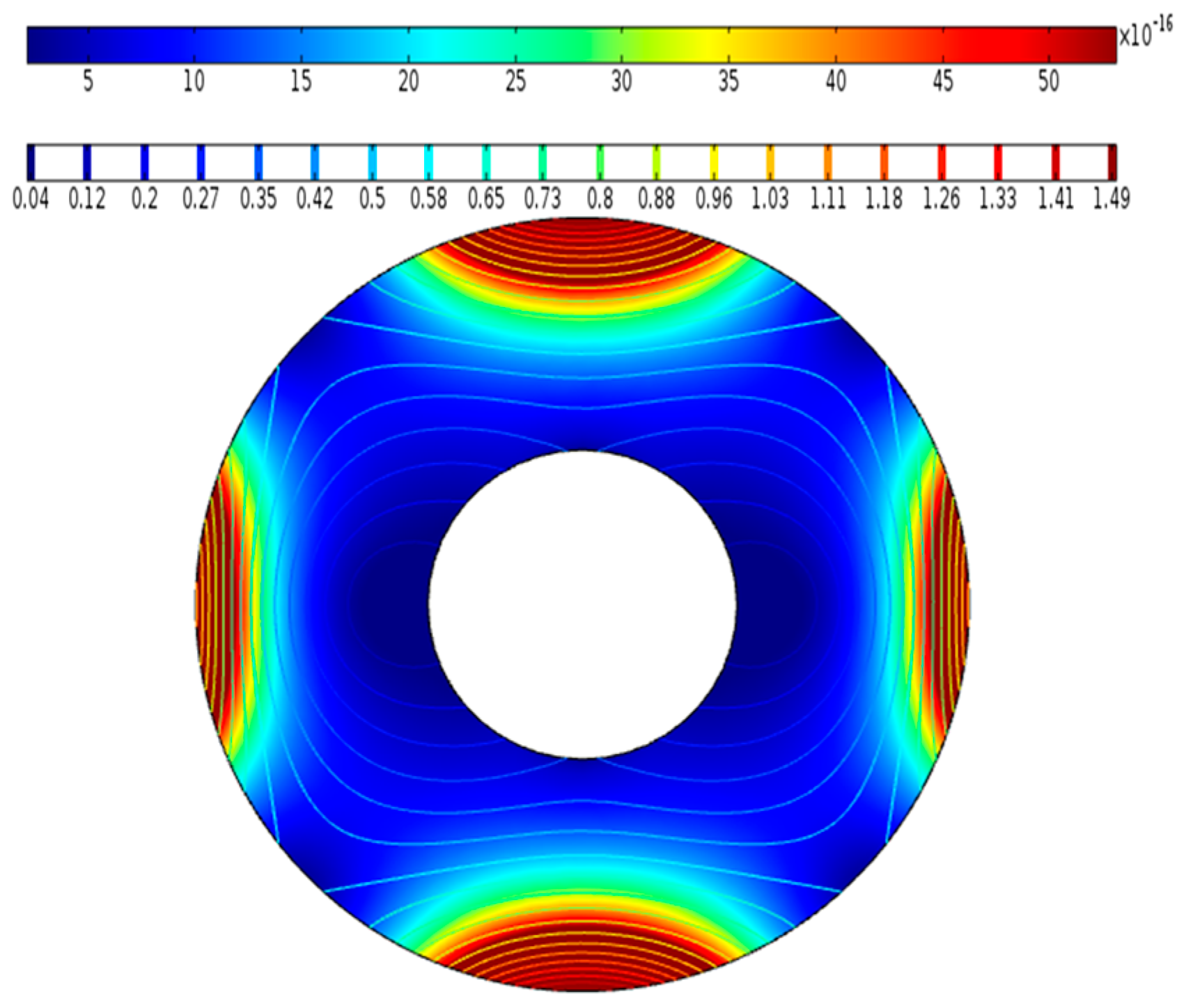
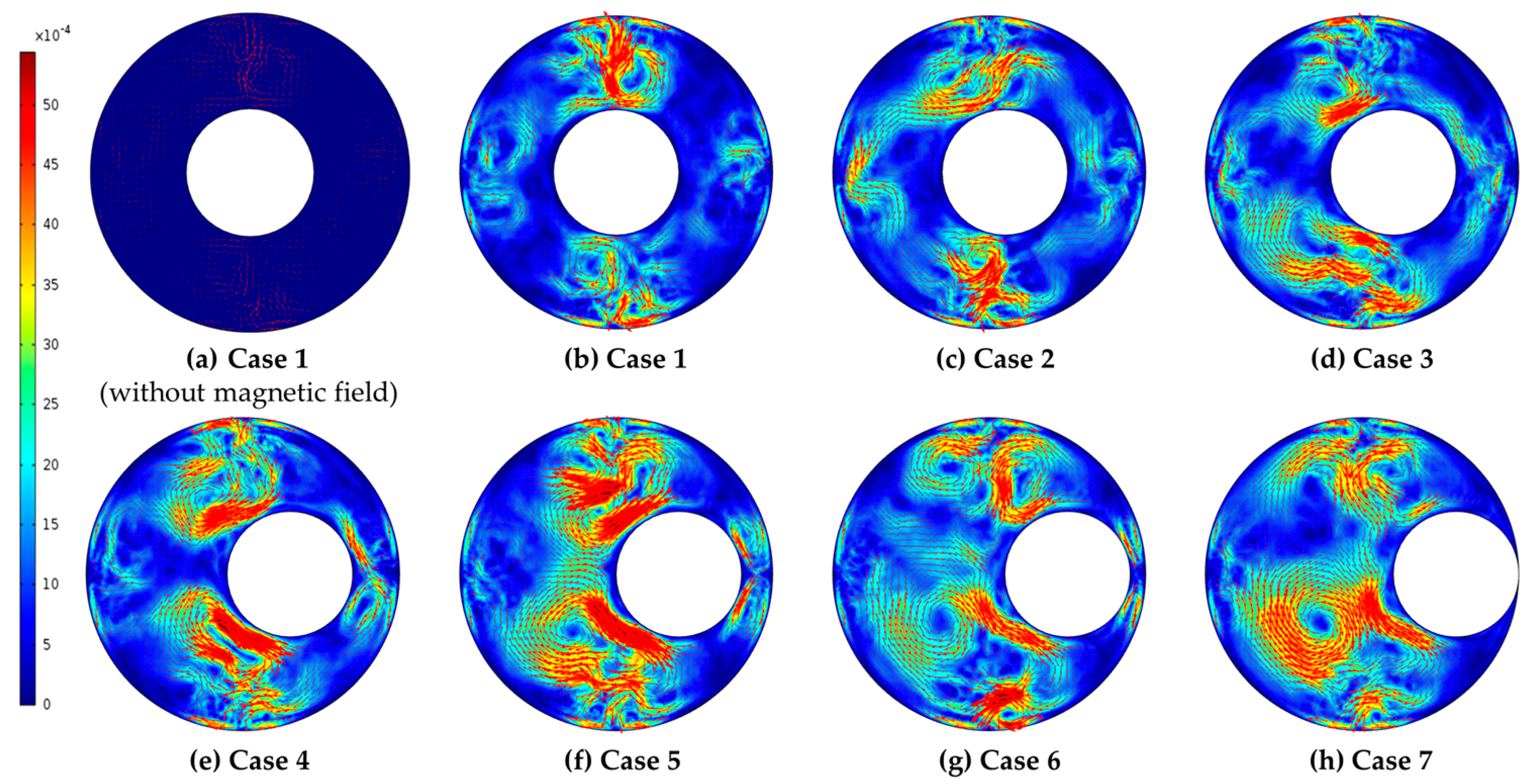

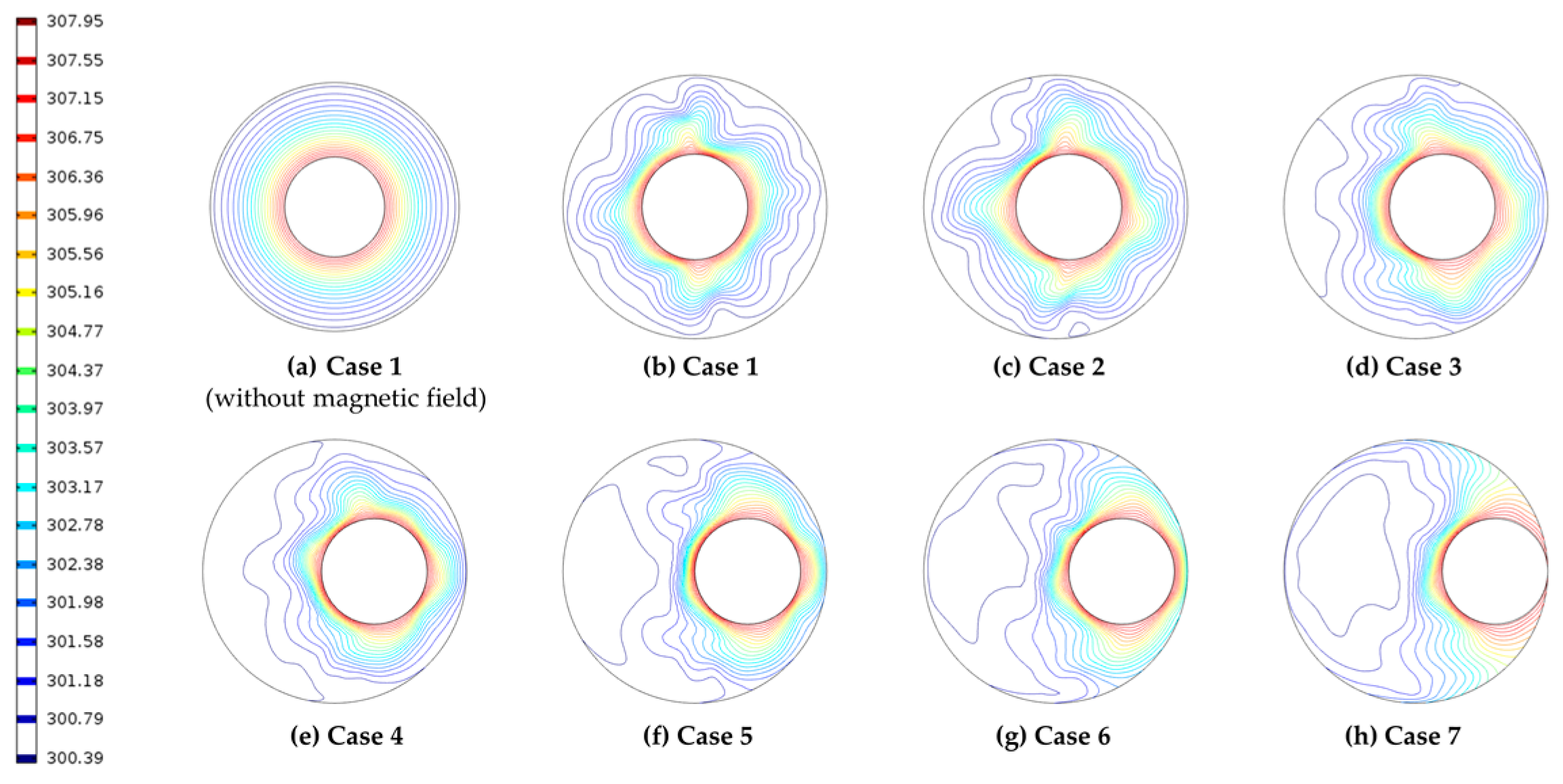
| Cases | Eccentricity, e |
|---|---|
| Case 1 (ref.) | 0 |
| Case 2 | 0.1 |
| Case 3 | 0.2 |
| Case 4 | 0.3 |
| Case 5 | 0.4 |
| Case 6 | 0.5 |
| Case 7 | 0.6 |
| Properties | Value |
|---|---|
| 1221 (kg/m3) | |
| 2.552 | |
| 2.208 | |
| 1.552 | |
| 0.00727 (Pa∙s) | |
| k | 0.19 (W/m∙K) |
| 1840 (J/kg∙K) | |
| 8.6 × 10−4 (1/K) |
| H | 10 (kA/mm) |
| 308.15 (K) | |
| 298.15 (K) | |
| Wall condition | No-slip |
© 2018 by the authors. Licensee MDPI, Basel, Switzerland. This article is an open access article distributed under the terms and conditions of the Creative Commons Attribution (CC BY) license (http://creativecommons.org/licenses/by/4.0/).
Share and Cite
Kim, J.-H.; Seo, H.-S.; Kim, Y.-J. Thermal-Flow Characteristics of Ferrofluids in a Rotating Eccentric Cylinder under External Magnetic Force. Micromachines 2018, 9, 457. https://doi.org/10.3390/mi9090457
Kim J-H, Seo H-S, Kim Y-J. Thermal-Flow Characteristics of Ferrofluids in a Rotating Eccentric Cylinder under External Magnetic Force. Micromachines. 2018; 9(9):457. https://doi.org/10.3390/mi9090457
Chicago/Turabian StyleKim, Jae-Hee, Hyeon-Seok Seo, and Youn-Jea Kim. 2018. "Thermal-Flow Characteristics of Ferrofluids in a Rotating Eccentric Cylinder under External Magnetic Force" Micromachines 9, no. 9: 457. https://doi.org/10.3390/mi9090457
APA StyleKim, J.-H., Seo, H.-S., & Kim, Y.-J. (2018). Thermal-Flow Characteristics of Ferrofluids in a Rotating Eccentric Cylinder under External Magnetic Force. Micromachines, 9(9), 457. https://doi.org/10.3390/mi9090457





